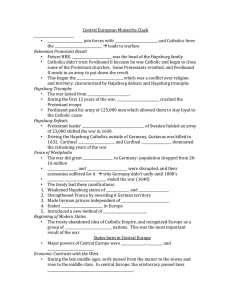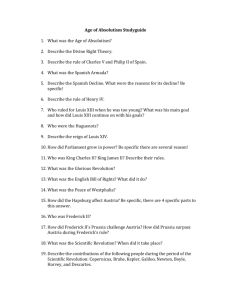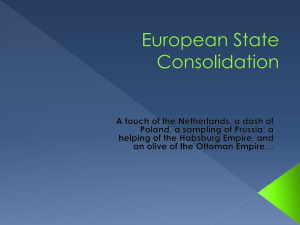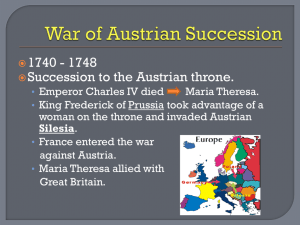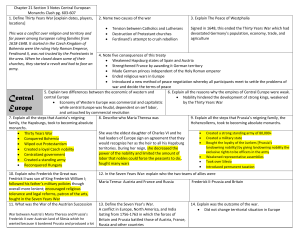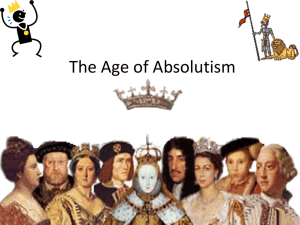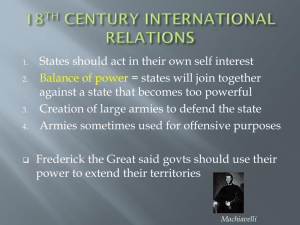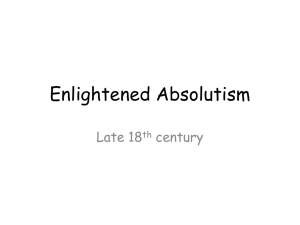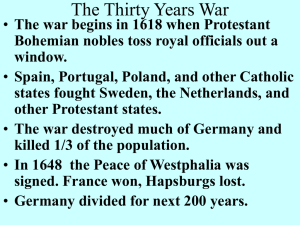Modern European History Central European Monarchs Clash Name: ___________________
advertisement
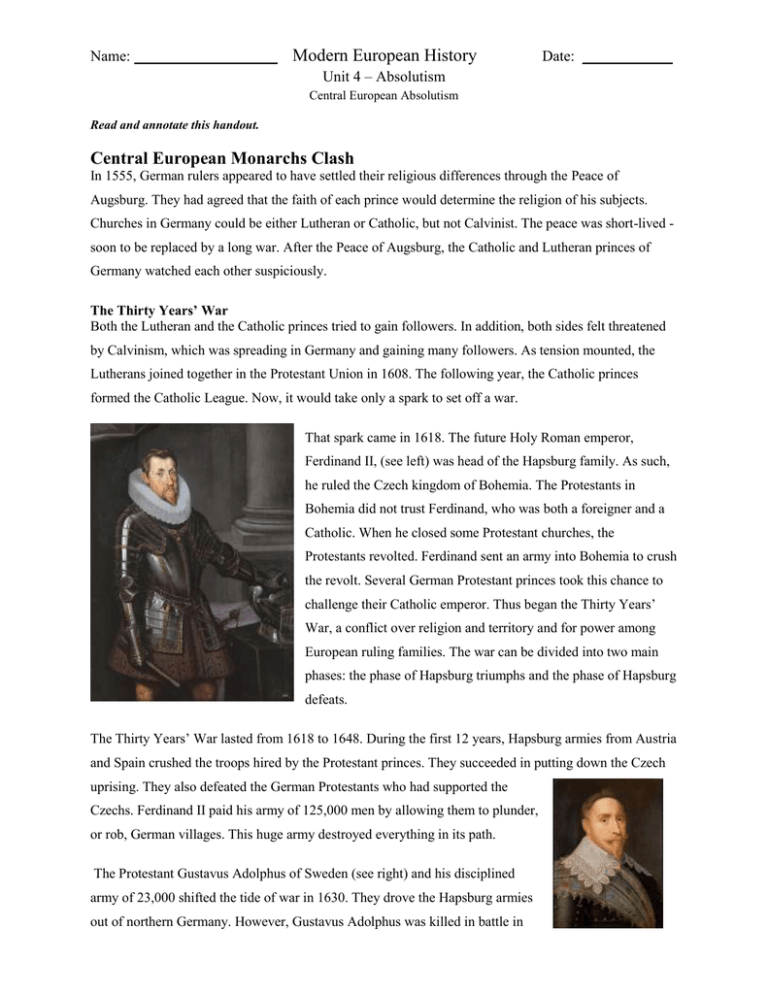
Name: ___________________ Modern European History Date: ____________ Unit 4 – Absolutism Central European Absolutism Read and annotate this handout. Central European Monarchs Clash In 1555, German rulers appeared to have settled their religious differences through the Peace of Augsburg. They had agreed that the faith of each prince would determine the religion of his subjects. Churches in Germany could be either Lutheran or Catholic, but not Calvinist. The peace was short-lived soon to be replaced by a long war. After the Peace of Augsburg, the Catholic and Lutheran princes of Germany watched each other suspiciously. The Thirty Years’ War Both the Lutheran and the Catholic princes tried to gain followers. In addition, both sides felt threatened by Calvinism, which was spreading in Germany and gaining many followers. As tension mounted, the Lutherans joined together in the Protestant Union in 1608. The following year, the Catholic princes formed the Catholic League. Now, it would take only a spark to set off a war. That spark came in 1618. The future Holy Roman emperor, Ferdinand II, (see left) was head of the Hapsburg family. As such, he ruled the Czech kingdom of Bohemia. The Protestants in Bohemia did not trust Ferdinand, who was both a foreigner and a Catholic. When he closed some Protestant churches, the Protestants revolted. Ferdinand sent an army into Bohemia to crush the revolt. Several German Protestant princes took this chance to challenge their Catholic emperor. Thus began the Thirty Years’ War, a conflict over religion and territory and for power among European ruling families. The war can be divided into two main phases: the phase of Hapsburg triumphs and the phase of Hapsburg defeats. The Thirty Years’ War lasted from 1618 to 1648. During the first 12 years, Hapsburg armies from Austria and Spain crushed the troops hired by the Protestant princes. They succeeded in putting down the Czech uprising. They also defeated the German Protestants who had supported the Czechs. Ferdinand II paid his army of 125,000 men by allowing them to plunder, or rob, German villages. This huge army destroyed everything in its path. The Protestant Gustavus Adolphus of Sweden (see right) and his disciplined army of 23,000 shifted the tide of war in 1630. They drove the Hapsburg armies out of northern Germany. However, Gustavus Adolphus was killed in battle in 1632. Cardinal Richelieu and Cardinal Mazarin of France dominated the remaining years of the war. Although Catholic, these two cardinals feared the Hapsburgs more than the Protestants. They did not want other European rulers to have as much power as the French king. Therefore, in 1635, Richelieu sent French troops to join the German and Swedish Protestants in their struggle against the Hapsburg armies. Peace of Westphalia The war did great damage to Germany. Its population dropped from 20 million to about 16 million. Both trade and agriculture were disrupted, and Germany’s economy was ruined. Germany had a long, difficult recovery from this devastation. That is a major reason it did not become a unified state until the 1800s. The Peace of Westphalia (1648) ended the war. The treaty had these important consequences: weakened the Hapsburg states of Spain and Austria; strengthened France by awarding it German territory; made German princes independent of the Holy Roman emperor; ended religious wars in Europe; introduced a new method of peace negotiation whereby all participants meet to settle the problems of a war and decide the terms of peace. (This method is still used today.) Beginning of Modern States The treaty of Westphalia abandoned the idea of a Catholic empire that would rule most of Europe. It recognized Europe as a group of equal, independent states. This marked the beginning of the modern state system and was the most important result of the Thirty Years’ War. 2 Strong states formed more slowly in central Europe than in western Europe. The major powers of this region were the kingdom of Poland, the Holy Roman Empire, and the Ottoman Empire. None of them was very strong in the mid-1600s. One reason for this is that the economy of central Europe developed differently from that of western Europe. During the late Middle Ages, serfs in western Europe slowly won freedom and moved to towns. There, they joined middle-class townspeople, who gained economic power because of the commercial revolution and the development of capitalism. By contrast, the landowning aristocracy in central Europe passed laws restricting the ability of serfs to gain freedom and move to cities. These nobles wanted to keep the serfs on the land, where they could produce large harvests. The nobles could then sell the surplus crops to western European cities at great profit. The landowning nobles in central Europe not only held down the serfs but also blocked the development of strong kings. For example, the Polish nobility elected the Polish king and sharply limited his power. They allowed the king little income, no law courts, and no standing army. As a result, there was not a strong ruler who could form a unified state. The two empires of central Europe were also weak. Although Suleyman the Magnificent had conquered Hungary and threatened Vienna in 1529, the Ottoman Empire could not take its European conquest any farther. From then on, the Ottoman Empire declined from its peak of power. In addition, the Holy Roman Empire was seriously weakened by the Thirty Years’ War. No longer able to command the obedience of the German states, the Holy Roman Empire had no real power. These old, weakened empires and kingdoms left a power vacuum in central Europe. In the late 1600s, two German-speaking families decided to try to fill this vacuum by becoming absolute rulers themselves. One of these families was the Hapsburgs of Austria. The Austrian Hapsburgs took several steps to become absolute monarchs. First, during the Thirty Years’ War, they reconquered Bohemia. The Hapsburgs wiped out Protestantism there and created a new Czech nobility that pledged loyalty to them. Second, after the war, the Hapsburg ruler centralized the government and created a standing army. Third, by 1699, the Hapsburgs had retaken Hungary from the Ottoman Empire In 1711, Charles VI became the Hapsburg ruler. Charles’s empire was a difficult one to rule. Within its borders lived a diverse assortment of people - Czechs, Hungarians, Italians, Croatians, and Germans. Only the fact that one Hapsburg ruler wore the Austrian, Hungarian, and Bohemian crowns kept the empire together. 3 Maria Theresa Inherits the Austrian Throne How could the Hapsburgs make sure that they continued to rule all those lands? Charles VI spent his entire reign working out an answer to this problem. With endless arm-twisting, he persuaded other leaders of Europe to sign an agreement that declared they would recognize Charles’s eldest daughter as the heir to all his Hapsburg territories. That heir was a young woman named Maria Theresa. In theory, this agreement guaranteed Maria Theresa a peaceful reign. Instead, she faced years of war. Her main enemy was Prussia, a state to the north of Austria. Like Austria, Prussia rose to power in the late 1600s. Like the Hapsburgs of Austria, Prussia’s ruling family, the Hohenzollerns, also had ambitions. Those ambitions threatened to upset central Europe’s delicate balance of power. The Rise of Prussia The Hohenzollerns built up their state from a number of small holdings, beginning with the German states of Brandenburg and Prussia. In 1640, a 20-year-old Hohenzollern named Frederick William inherited the title of elector of Brandenburg. After seeing the destruction of the Thirty Years’War, Frederick William, later known as the Great Elector (see left), decided that having a strong army was the only way to ensure safety. To protect their lands, the Great Elector and his descendants moved toward absolute monarchy. They created a standing army, the best in Europe. They built it to a force of 80,000 men. To pay for the army, they introduced permanent taxation. Beginning with the Great Elector’s son, they called themselves kings. They also weakened the representative assemblies of their territories. Prussia’s landowning nobility, the Junkers, resisted the king’s growing power. However, in the early 1700s, King Frederick William I bought their cooperation. He gave the Junkers the exclusive right to be officers in his army. As a result, Prussia became a rigidly controlled, highly militarized society. Frederick the Great Frederick William worried that his son, Frederick (see left), was not militaryminded enough to rule. The prince loved music, philosophy, and poetry. In 1730, when he and a friend tried to run away, they were caught. To punish Frederick, the king ordered him to witness his friend’s beheading. Despite such bitter memories, Frederick II, known as Frederick the Great, followed his father’s military policies when he came to power. However, he also softened some of his father’s laws. With regard to domestic affairs, he encouraged religious toleration and legal reform. According to his theory of government, Frederick believed that a ruler should be like a father to his people: 4 A prince . . . is only the first servant of the state, who is obliged to act with probity [honesty] and prudence. . . . As the sovereign is properly the head of a family of citizens, the father of his people, he ought on all occasions to be the last refuge of the unfortunate. FREDERICK II, Essay on Forms of Government Frederick the Great was practical and atheistic and died without a son to succeed him. An aggressor in foreign affairs, Frederick once wrote that “the fundamental role of governments is the principle of extending their territories.” Frederick earned the title “the Great” by achieving his goals for Prussia. War of the Austrian Succession In 1740, Maria Theresa succeeded her father, just five months after Frederick II became king of Prussia. Frederick wanted the Austrian land of Silesia, which bordered Prussia. Silesia produced iron ore, textiles, and food products. Frederick underestimated Maria Theresa’s strength. He assumed that because she was a woman, she would not be forceful enough to defend her lands. In 1740, he sent his army to occupy Silesia, beginning the War of the Austrian Succession. (above) Maria Theresa married at the age of 19 and gave birth to sixteen children over the course of 20 years. She ascended to the Austrian throne in 1745 at the age of 28 and ruled until 1780, when she died at the age of 63. An able ruler, Maria Theresa also devoted herself to her children, whom she continued to advise even after they were grown. Perhaps her most famous child was Marie Antoinette, wife of Louis XVI of France. As the Austrian empress, Maria Theresa decreased the power of the nobility. She also limited the amount of labor that nobles could force peasants to do. She argued: “The peasantry must be able to sustain itself.” Even though Maria Theresa had recently given birth, she journeyed to Hungary. There she held her infant in her arms as she asked the Hungarian nobles for aid. Even though the nobles resented their Hapsburg rulers, they pledged to give Maria Theresa an army. Great Britain also joined Austria to fight its longtime enemy France, which was Prussia’s ally. Although Maria Theresa did stop Prussia’s aggression, she lost Silesia in the Treaty of Aix-la-Chapelle in 1748. With the acquisition of Silesia, Prussia became a major European power. The Seven Years’ War Maria Theresa decided that the French kings were no longer Austria’s chief enemies. She made an alliance with them. The result was a diplomatic revolution. When Frederick heard of her actions, he signed a treaty with Britain - Austria’s former ally. Now, Austria, France, Russia, and others were allied against Britain and Prussia. Not only had Austria and Prussia switched allies, but for the first time, Russia was playing a role in European affairs. In 1756, Frederick attacked Saxony, an Austrian ally. Soon every great European power was involved in the war. Fought in Europe, India, and North America, the war lasted until 1763. It was called the Seven Years’ War. The war did not change the territorial situation in Europe. It was a different story on other continents. Both France and Britain had colonies in North America and the West Indies. Both were competing economically in India. The British emerged as the real victors in the Seven Years’ War. France lost its colonies in North America, and Britain gained sole economic domination of India. 5
